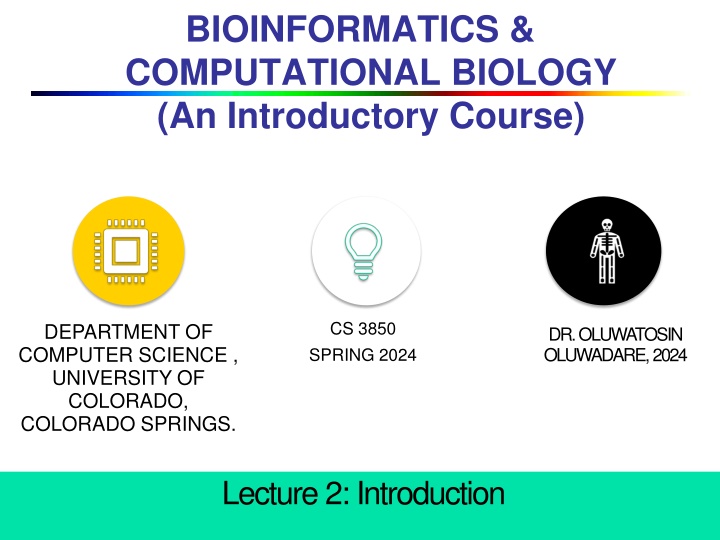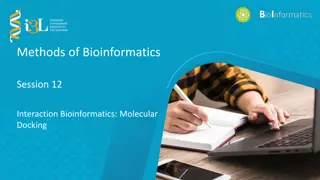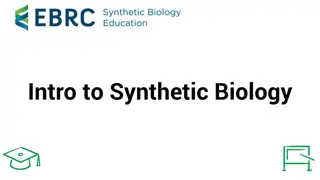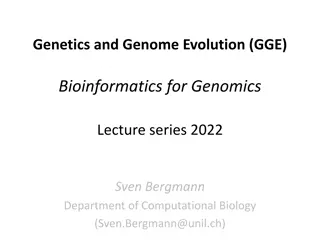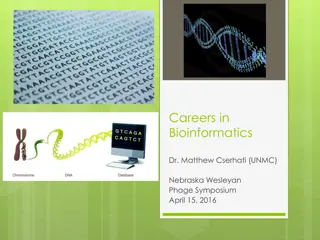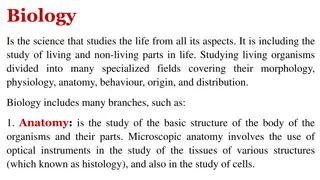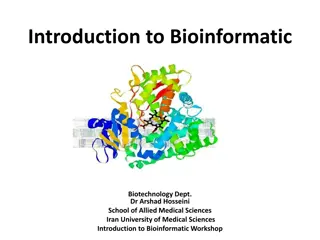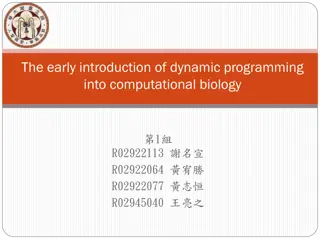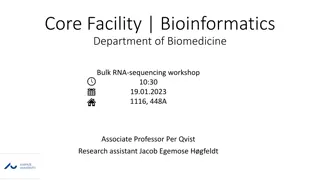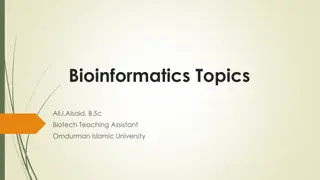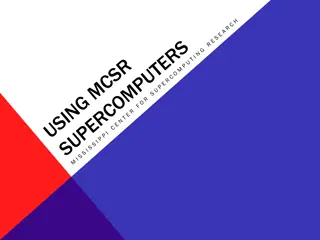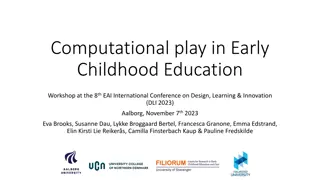Introduction to Bioinformatics and Computational Biology
Bioinformatics is the interdisciplinary field that applies computation and analysis tools to interpret biological data, bridging molecular biology and computer science. It aims to explore, analyze, and understand genomic data to enable new biological insights and principles. Various definitions from sources like NCBI and Wikipedia highlight bioinformatics as merging biology with computer science to develop methods for understanding complex biological data sets.
Download Presentation

Please find below an Image/Link to download the presentation.
The content on the website is provided AS IS for your information and personal use only. It may not be sold, licensed, or shared on other websites without obtaining consent from the author.If you encounter any issues during the download, it is possible that the publisher has removed the file from their server.
You are allowed to download the files provided on this website for personal or commercial use, subject to the condition that they are used lawfully. All files are the property of their respective owners.
The content on the website is provided AS IS for your information and personal use only. It may not be sold, licensed, or shared on other websites without obtaining consent from the author.
E N D
Presentation Transcript
BIOINFORMATICS & COMPUTATIONAL BIOLOGY (An Introductory Course) CS 3850 SPRING 2024 DEPARTMENT OF COMPUTER SCIENCE , UNIVERSITY OF COLORADO, COLORADO SPRINGS. DR. OLUWATOSIN OLUWADARE, 2024 Lecture 2: Introduction
Contents What is Bioinformatics ? Bioinformatics and Data Mining What is Computational Biology ? Why Bioinformatics ? Types of Data Available Bioinformatics Databases Problems in Bioinformatics The Question Some common analysis tools Summary 2 February 18, 2025 Computational Biology & Bioinformatics
What is Bioinformatics? Bioinformatics is defined as the application of tools of computation and analysis to the capture and interpretation of biological data. It is an interdisciplinary field, which harnesses computer science, mathematics, physics, and biology. Bioinformatics is the new science at the interface of molecular biology and computer science that seeks to develop better ways to explore, analyze, and understand this vast wealth of genomic data. 3 February 18, 2025 Computational Biology & Bioinformatics
What is Bioinformatics? Other Definitions The National Centre for Biotechnology Information (NCBI 2001): Bioinformatics is the field of science in which biology, computer science, and information technology merge into a single discipline. The ultimate goal of the field is to enable the discovery of new biological insights and to create a global perspective from which unifying principles in biology can be discerned. http://www.ncbi.nlm.nih.gov/About/primer/bioinformatics.html 4 February 18, 2025 Computational Biology & Bioinformatics
What is Bioinformatics? Other Definitions Wikipedia.org: Bioinformatics is an interdisciplinary field that develops methods and software tools for understanding biological data, in particular, when the data sets are large and complex. As an interdisciplinary field of science, bioinformatics combines biology, computer science, information engineering, mathematics and statistics to analyze and interpret the biological data. 5 February 18, 2025 Computational Biology & Bioinformatics
What is Bioinformatics? Biology Computer Science Bioinformatics Mathematics/ Statistics Medicine 6 February 18, 2025 Computational Biology & Bioinformatics
Contents What is Bioinformatics ? Bioinformatics and Data Mining What is Computational Biology ? Why Bioinformatics ? Types of Data Available Bioinformatics Databases Problems in Bioinformatics The Question Some common analysis tools Summary 7 February 18, 2025 Computational Biology & Bioinformatics
Bioinformatics and Data Mining What Is Data Mining? Data mining (knowledge discovery from data) Extraction of interesting (non-trivial, implicit, previously unknown and potentially useful)patterns or knowledge from huge amount of data Data mining: a misnomer? Alternative names Knowledge discovery (mining) in databases (KDD), knowledge extraction, data/pattern analysis, data archeology, data dredging, information harvesting, business intelligence, etc. Watch out: Is everything data mining ? Simple search and query processing (Deductive) expert systems 8 Slide from CS4435/5435: Data Mining
Bioinformatics and Data Mining Bioinformatics involves: the design of new algorithms and statistics for large molecular biology data sets analysis . the design and construction of software that enable information extraction. the analysis and interpretation of biological data including nucleotide and amino acid sequences, and protein structures using developed software tools. We can imply that Bioinformatics is the mining of biological datasets 9 February 18, 2025 Computational Biology & Bioinformatics
Contents What is Bioinformatics ? Bioinformatics and Data Mining What is Computational Biology ? Why Bioinformatics ? Types of Data Available Bioinformatics Databases Problems in Bioinformatics The Question Some common analysis tools Summary 10 February 18, 2025 Computational Biology & Bioinformatics
Computational Biology Computational biology isthe application of mathematical methods and computer algorithms to biological problems. Simply put, it is about studying biology using computational techniques, which further the understanding of the science. Bioinformatics can be regarded as a branch of computational biology. 11 February 18, 2025 Computational Biology & Bioinformatics
Contents What is Bioinformatics ? Bioinformatics and Data Mining What is Computational Biology ? Why Bioinformatics ? Types of Data Available Bioinformatics Databases Problems in Bioinformatics The Question Some common analysis tools Summary 12 February 18, 2025 Computational Biology & Bioinformatics
Why Bioinformatics? It provide an avenue for a better understanding of complex disorders such as PD, increasing our ability to work toward improved treatments or cures. It solves existing biological questions using existing and newly developed algorithms and software tools. Provides a better data management and visualization analysis for the growing amount of available datasets. 13 February 18, 2025 Computational Biology & Bioinformatics
Contents What is Bioinformatics ? Bioinformatics and Data Mining What is Computational Biology ? Why Bioinformatics ? Types of Data Available Bioinformatics Databases Problems in Bioinformatics The Question Some common analysis tools Summary 14 February 18, 2025 Computational Biology & Bioinformatics
Types of Data available DNA/RNA Sequence Data Protein Sequence Data Protein structure Data Protein function Gene expression Data Biomolecular interactions Single Nucleotide Polymorphisms (SNPs) Molecular pathways Disease information And many more 15 February 18, 2025 Computational Biology & Bioinformatics
GenBank Data Growth Clair, C. S., & Visick, J. E. (2013). 16 February 18, 2025 Computational Biology & Bioinformatics
Growth of PDB https://www.rcsb.org/stats/growth/growth-released-structures 17 February 18, 2025 Computational Biology & Bioinformatics
Contents What is Bioinformatics ? Bioinformatics and Data Mining What is Computational Biology ? Why Bioinformatics ? Types of Data Available Bioinformatics Databases Problems in Bioinformatics The Question Some common analysis tools Summary 18 February 18, 2025 Computational Biology & Bioinformatics
Popular Databases and Type of Data Stored Database Data Stored GenBank DNA/RNA Sequence Data UniProtKB Protein Sequence Data Protein DataBank Protein structure Data Gene Ontology Protein function Data Gene Expression Omnibus (GEO) Gene expression Data dbSNP SNPs KEGG PATHWAY Molecular pathways 19 February 18, 2025 Computational Biology & Bioinformatics
Other Databases GSDB: Genome Structure Database Store Three-Dimensional Chromosome and Genome Structure 20 February 18, 2025 Computational Biology & Bioinformatics
Contents What is Bioinformatics ? Bioinformatics and Data Mining What is Computational Biology ? Why Bioinformatics ? Types of Data Available Bioinformatics Databases Problems in Bioinformatics The Question Some common analysis tools Summary 21 February 18, 2025 Computational Biology & Bioinformatics
Problems affecting Analysis Database Data Quality Additional Noise stemming from Incorrect interpretation of experiments and incorrect handling Incorrect parameter entry in public databases Spelling mistakes Annotation errors Frame shift errors 22 February 18, 2025 Computational Biology & Bioinformatics
Problems affecting Analysis Database Redundancy Data from different experimental approach for same organism Sequence discrepancies and variation As a result of redundancy if data used for training and testing are closely related. Then the developed model will lack ability to generalize. 23 February 18, 2025 Computational Biology & Bioinformatics
Contents What is Bioinformatics ? Bioinformatics and Data Mining What is Computational Biology ? Why Bioinformatics ? Types of Data Available Bioinformatics Databases Problems in Bioinformatics The Question Some common analysis tools Summary 24 February 18, 2025 Computational Biology & Bioinformatics
The Million Dollar Question What do we do with these huge amount of data? Alternatively, should our question be, What can we get from these huge and growing amount of data? 25 February 18, 2025 Computational Biology & Bioinformatics
What do we do with these huge amount of data? Store Search Analyze, Annotate, visualize and Recognize patterns Build biological models and make Predictions 26 February 18, 2025 Computational Biology & Bioinformatics
What do we do with these huge amount of data? Need to have some biological knowledge to know the questions to ask. Need to have knowledge of the data to know what possible questions it could answer. What are the research areas/topics in bioinformatics? 27 February 18, 2025 Computational Biology & Bioinformatics
Contents What is Bioinformatics ? Bioinformatics and Data Mining What is Computational Biology ? Why Bioinformatics ? Types of Data Available Bioinformatics Databases Problems in Bioinformatics The Question Some common analysis tools Summary 28 February 18, 2025 Computational Biology & Bioinformatics
Common Tools used for Analysis BLAST(Basic Local Alignment Search Tool) Sequence similarity( Homology ) searching Clustal Omega(Protein)/ MUSCLE (DNA Alignment) Sequence Alignment GenScan To identify complete gene structures in genomic DNA. UniFold RNA Structure JPred Protein Structure Prediction PHYLIP Phylogenetics: Inferring evolutionary relationships among biological entities. 29 February 18, 2025 Computational Biology & Bioinformatics
Methodology for Tool development in Bioinformatics Formulate Hypothesis Refine Develop Model Hypothesis/Model Validate Result Run Analysis 30 February 18, 2025 Computational Biology & Bioinformatics
Summary Bioinformatics is the application of tools of computation and analysis to the capture and interpretation of biological data Bioinformatics is essential for management of data in modern biology and medicine The bioinformatics toolbox includes computer software programs such as BLAST and Ensembl, which depend on the availability of the internet Many tools have been developed to ensure knowledge can be extracted from biological datasets Errors due to data handing and redundancy is common in bioinformatics. Hence, an efficient data preprocessing or normalization method is needed. 31 February 18, 2025 Computational Biology & Bioinformatics
Computer Scientist vs Biologist (Serafim Batzoglou, Stanford) February 18, 2025 Computational Biology & Bioinformatics 32 32
Computer Scientist vs Biologist (almost) Everything is true or false in computer science (almost) Nothing is ever true or false in Biology 33 February 18, 2025 Computational Biology & Bioinformatics
Computer Scientist vs Biologist Biologists seek to understand the complicated, messy natural world Computer scientists strive to build their own clean and organized virtual world 34 February 18, 2025 Computational Biology & Bioinformatics
Computer Scientist vs Biologist Computer scientists are obsessed with being the first to invent or prove something Biologists are obsessed with being the first to discover something 35 February 18, 2025 Computational Biology & Bioinformatics
References Clair, C. S., & Visick, J. E. (2013). Exploring bioinformatics. Jones & Bartlett Publishers Bayat, A. (2002). Bioinformatics. Bmj, 324(7344), 1018-1022. http://www.ncbi.nlm.nih.gov/About/primer/bioinformatics.html https://www.nature.com/subjects/systems-biology Bioinformatics: The Machine Learning Approach, Pierre Baldi and Soren Brunak, 2001, MIT press. Dr. Jianhua Ruan, Department of Computer Science, UTSA Dr. Jianlin Cheng, Deparmtment of Electrical Engineering and Computer Science, University of Missouri, Columbia 36 February 18, 2025 Computational Biology & Bioinformatics
